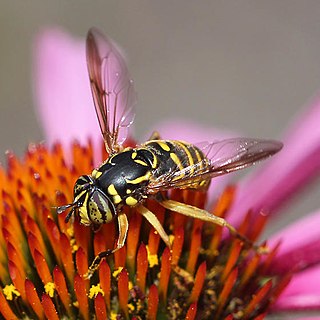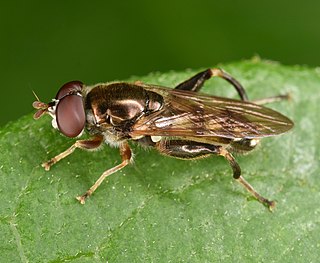
Tropidia is a genus hoverflies, from the family Syrphidae, in the order Diptera.

Teuchocnemus is a genus of North American flower flies.

Spilomyia citima, the Western Hornet Fly, is a rare species of syrphid fly first officially described by Vockeroth in 1958. Hoverflies get their names from the ability to remain nearly motionless while in flight. The adults are also known as flower flies for they are commonly found around and on flowers, from which they get both energy-giving nectar and protein-rich pollen. The larvae are known as the short-tailed larvae suited for moist areas such as rot holes of trees.

Somula decora, commonly known as the spotted wood fly, is an uncommon species of syrphid fly observed in central to eastern North America. Hoverflies can remain nearly motionless in flight. The adults are also known as flower flies for they are commonly found on flowers, from which they get both energy-giving nectar and protein-rich pollen. The larvae live in decaying wood.
Milesia scutellata is a species of hoverfly in the family Syrphidae.
Criorhina tricolor is a species of hoverfly in the family Syrphidae.
Sphecomyia columbiana is a species of syrphid fly in the family Syrphidae.

Chalcosyrphus (Xylotomima) metallicus, the Yellow-legged Leafwalker, is an uncommon species of syrphid fly observed in the southeastern United States. Hoverflies are able to remain nearly motionless while in flight. The adults are also known as flower flies for they are commonly found around and on flowers, from which they get both energy-giving nectar and protein-rich pollen.

Spilomyia alcimus, the Broad-banded Hornet Fly, is an uncommon species of syrphid fly first officially described by Walker in 1849. Hoverflies get their names from the ability to remain nearly motionless while in flight. The adults are also known as flower flies for they are commonly found around and on flowers, from which they get both energy-giving nectar and protein-rich pollen. The larvae are known as the short-tailed larvae suited for moist areas such as rot holes of trees.
Spilomyia foxleei is a species of syrphid fly in the family Syrphidae.
Somula mississippiensis is a species of syrphid fly in the family Syrphidae.
Xylota nitidula is a species of hoverfly in the family Syrphidae.
Neoascia sphaerophoria is a species of Hoverfly in the family Syrphidae.
Neoascia subchalybea is a species of Hoverfly in the family Syrphidae.
Neoascia guttata is a species of Hoverfly in the family Syrphidae.
Sphegina rufa is a species of hoverfly in the family Syrphidae.
Sphegina bridwelli is a species of hoverfly in the family Syrphidae.
Sphegina infuscata is a species of hoverfly in the family Syrphidae.
Sphegina nigrimanus is a species of hoverfly in the family Syrphidae.
Brachyopa cummingi is a species of hoverfly in the family Syrphidae.







